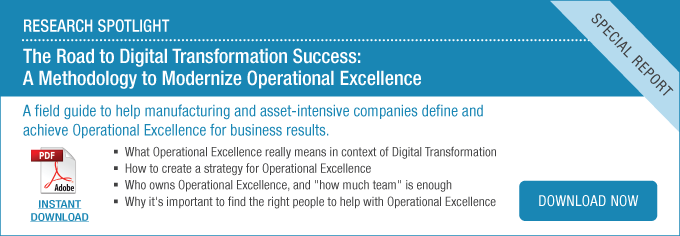We’ve been discussing the “Executive Business Case for Quality” research with a number of Operational Excellence (OpEx) leaders. Many OpEx leaders are attempting to build business cases for technology investments, and one recurring theme of our discussions is that leaders want to justify technology investments by quantifying expected improvements to process and personnel behavior enabled by the technologies.
Click here to speak to Dan
Unfortunately, a second recurring theme is that neither corporations nor industry have the data needed to convincingly quantify these improvements. Therefore, OpEx leaders resort to basing their business cases on departmental metrics and labor costs with unforeseen consequences.
An All-Too-Common Example
Let’s examine a case of a business case for technology that will electronically manage processes while monitoring system health through real-time dashboards, metrics, and analytics. Currently, the department uses a fragmented approach to managing the processes and generates monthly status reports on a subset of data they’ll get in the new system. Manually generating the data takes quite a bit of time – 12 hours – which prevents it from being generated more frequently. The new system is expected to provide real-time visibility and intelligence, which will enable more informed and proactive decisions. It would also free up quite a bit of time due to improved efficiency. The OpEx leader expects to use this time to work on value-adding activities such as continuous improvement.
Our OpEx leader would like to calculate ROI (Return on Investment) based on the benefits of more informed and proactive decision-making due to the real-time data, and the benefits of the value-added activities that they simply don’t have time for today. Makes sense, because that’s the intent of the technology investment, right?
Unfortunately, this leads us to our second recurring theme: lack of supporting data. There is little published industry data that supports the value of automating specific OpEx processes, or real-time access to OpEx data. There are case studies, but it’s easy for budget holders to disavow benefits from a single case study, or even several, because each case study is based on a specific circumstance.
Unfortunately, this is where it is easy to fall into a common trap of justifying the investment based on reduced labor due to increased efficiency, among other tactical reasons (reducing # IT systems, reducing # customer complaints, etc).
Lost Personnel
Taken literally, a proposal that relies on labor reduction will do just that – reduce headcount from the department in question. Unfortunately, finance team should be expected to take this literally. Unfortunately, this doesn’t hit on the value we are trying to accomplish in our example. Losing personnel from the department is counter to our intentions of driving continuous improvement in order to improve the excellence of our operations.
Lost Morale
Imagine being displaced by technology, or seeing your co-workers displaced. This can create an atmosphere of uncertainty, distrust, and fear; all which can lead to reduced efficiencies and negate at least some of the anticipated value of the investment. Again, this is counterproductive to our anticipated goals.
Seize an Opportunity
Every business case and ROI is an opportunity to showcase how a group/function/department supports and enables the company’s strategic objectives. Keep digging to find the connection to corporate strategy, even if the direct impact may be difficult to prove. Demonstrating that the business case is aligned with the big picture and actively supports strategic objectives can be a meaningful step toward top executive sponsorship. In one recent discussion, we found that there was an ongoing corporate-wide Hadoop initiative that this initiative dovetailed with nicely. The requested technology would enable a pillar of Operational Excellence to feed the big data initiative, enabling the corporate-wide connected data model being championed by the C-suite.
You’ll likely still need data to justify your business case. Fortunately, data and more strategies are contained in LNS’s eBook, spotlight, and On-Demand webcast recording published as a part of the “Quality in the Boardroom, the executive business case for EQMS” research. This can serve as a valuable starting point to differentiating your current and future business cases.
